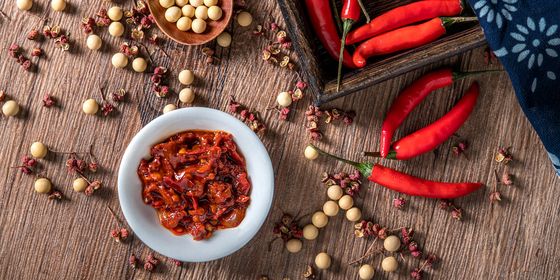A Chongqing soup that gets the blood boiling
“Definitely not for the faint of heart,” a user on catering platform Food Fanatic writes of Chongqing’s beloved “raw blood” soup, mao xie wang (毛血旺). Consisting of blood curds, tripe, and other choice animal organs boiled in a pungent, bright red broth of chili sauce and Sichuan peppercorns, the dish resembles a vampire’s feast in looks as well as name.
Yet Chinese diners can’t get enough of it: According to review app Meituan-Dianping, this sanguine soup was the number-one selling restaurant and take-out dish in all first-tier Chinese cities in 2017. Its name is also written as 冒血旺, with 冒 meaning “rough” in the Chongqing dialect. The 血旺 (“blood curds”) or 血豆腐 (“blood tofu”) are usually made of duck, pig, or chicken blood, seasoned with salt and heated to form a solid block.
Though the exact origin of blood consumption in China is unclear, blood began to be served as part of religious rituals as far back as the Zhou dynasty (1046 – 256 BCE), according to The Rites of Zhou. During the Han dynasty (206 BCE – 220 AD), a medical text listed pig’s blood as a treatment for strokes and headaches, and the 16th century’s Compendium of Materia Medica suggested duck’s blood as an antidote to poison. The consumption of innards likely originated from food shortages in ancient times and the folk belief that eating animal organs nourishes the corresponding human parts.
Mao xie wang’s origin is more recent: Legend states that in the 1940s, a butcher’s wife in the town of Ciqikou, Chongqing, was loath to waste the leftover pig innards and scraps from her husband’s shop, and decided to sell them in a soup. One day, the woman accidentally tipped some blood curd into the broth, and, surprisingly, found that the blood grew tender and flavorsome after boiling, so the dish caught on. These days, duck’s blood is more commonly used than pig’s blood for its fresher taste and softer texture.
After Chongqing separated from Sichuan province to form a municipality in 1997, the local food, known as Yu (渝) cuisine, has grown in popularity and developed a reputation distinct from the Sichuanese culinary tradition. It is also known as jianghu (江湖, folk) cuisine for its large portions, grassroots origins, and innovations with different ingredients and cooking methods. In 2012, the municipal authority released standardized recipes for 12 signature Yu dishes, including mao xie wang. Still, the recipe for “raw blood soup” varies across the nation. It can be made with custom ingredients, or a ready-made hot pot soup base.
Ingredients:
500g duck blood curd 鸭血
100g beef tripe 毛肚
100g ham 火腿
10g squid 鱿鱼
15g leek 大葱
10g dried chili pepper 干红辣椒
10g Sichuan peppercorn 花椒
10g ginger 姜
10g coriander 香菜
60g Chongqing hot pot soup base 重庆火锅底料
5tsp vegetable oil 植物油
2tsp Pixian Bean Sauce郫县豆瓣酱
1tsp yellow rice wine 黄酒
3g salt 盐
Steps:
- Cut the blood and ham into 3cm cubes, and the tripe into smaller pieces. Cut the squid segments into flower shapes
- Chop the dried chili pepper, leek, and coriander; slice the ginger
- Boil the ginger and the leeks in 1 liter of water. Add the blood curds, ham, and squid. Boil together for 1 minute, drain, and set aside
- Heat 2 tsp of oil in a wok. Fry the soup base and bean sauce until melted. Add 500 ml water and 1 tsp of yellow rice wine
- Cook the ham, blood, and squid mixture from Step Three in the boiled soup for 4 minutes, and add the salt. Add the tripe, cook for a further minute, and then pour into a bowl
- Heat 3 tsp of oil, and fry the chili pepper and Sichuan peppercorn over low heat until aromatic. Pour the oil into the bowl and serve with coriander
Red Recipe is a story from our issue, “Alpine Ambitions.” To read the entire issue, become a subscriber and receive the full magazine. Alternatively, you can purchase the digital version from the App Store.














